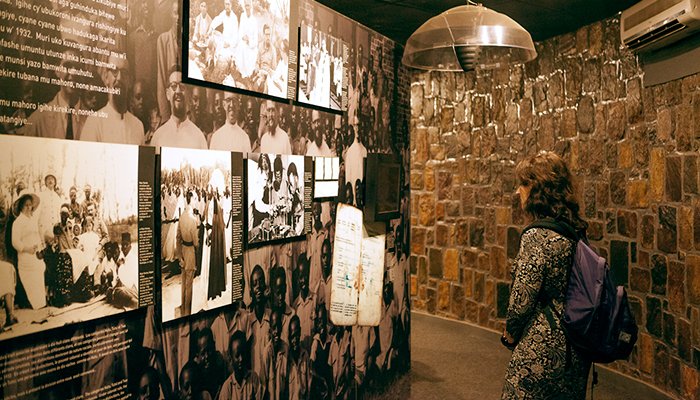This is part two of a three-part series on the Rwandan Genocide. The first piece can be found here.
The information, at first, is clinical. The first few panels are essentially a sketch of a history lesson, a bare framework on which to hang the rest of the tragedy. There are tiny bits about tribes and population, but the story doesn't really begin until the arrival of Dutch settlers in the late 19th century.
Of course it does, I immediately think. When you hear about a tribal battle based on insignificant racial distinctions, the odds that the conflict sourced from vaguely well-meaning European colonists are astronomically high. This is what we have always done. John Oliver had a good bit the other week about how being British is a little like being an alcoholic. "When someone says you did something awful, you find yourself going, 'honestly, I don't even remember doing that but, yeah, probably, probably!'"
The difference is so small – the tiniest difference in skin tone, the shape of the bridge of a nose – but it was enough for the colonists to decide that these people were more like them than those people, and all the nonsensical racism that follows such a statement came shortly thereafter.
A century, I think. That's how long it look before this whim of a classification became identity, and then separation, and then disgust, and then hatred, and then murder. The museum seems to be operating as a guide for how many generations it takes us to lose all sense of humanity.
The curling exhibit path leaves me for a moment at the base of another flight of stairs. At the top is a brightly-colored stained glass display of a narrow white staircase, surrounded by swirls of iridescent blue. My ever-present narrator informs me that the piece was commissioned by the museum to represent the genocide. A pile of skulls at the bottom represents the horror of the holocaust, the light at the top of the stair represents the hope that followed.
I don’t know if I am allowed to move closer, and yet I suddenly find myself standing at the top of the steps, only a few feet away from the glass. As I stand there, the screaming begins again, a new voice this time, shuddering its way through the window as I study its luminescent panes.
No matter how long I stand there looking, I never see the light at the top of the stairs. It always looks like a path leading to nowhere to me.
I walk away, down the hallway, along a dark crimson carpet. Except, no, the carpet is brown. It is only my imagination that makes it red. It is only my imagination that soaks it with blood.
By the time I am halfway through the displays, I have pulled out my phone to take pictures. Not artistic pictures, the sort I would normally sneak about to get: portraits of strangers standing in the shadows, gravely studying sorrow. Instead, I take pictures of the displays. Pictures of facts. When I get home, I write them down word for word, so I don't ever forget what they said.
Tutsi women were systematically raped and sexually mutilated as a weapon of genocide. The rapes were often performed by HIV-positive men, who were then given access to anti-retroviral medication. The women were not.
There are political cartoons on the wall here, but ones of such utter strangeness that I cannot fathom how anyone ever took them serious enough to print. In one, a Tutsi military leader is pictured marching his troops over the caskets of Hutus, shouting over his shoulder, “Cockroaches, fighters, let’s go! We are coming to live by force with those from whom we have robbed everything!” I study the drawing carefully for a long moment, wondering what sort of newspaper would run such a piece of disturbing propaganda, and what sort of person it would take to believe it.
Many of the Hutus seemed to believe that the Tutsis were on the verge of attacking them and wiping them out, that the genocide was an act of protection. All this, even though the Hutu people outnumbered the Tutsis by almost nine to one. Fear is powerful. Even more powerful than hate, perhaps.
I feel dizzy. I can't tell if I'm walking straight anymore. The blood rises from the carpet, and I am wading in it now.
Children were frequently forced to participate, often by killing their friends or neighbors.
Victims were sometimes forced to kill their loved ones just before they themselves were killed.
There is a video of corpses lying ignored on the street, blood pooled underneath them. Sometimes they lie face-down, and that is better, because I can’t see their faces. It is so much worse when I see the faces.
The video ends with a long shot of an execution, filmed shakily out the second-floor window of a house. Distant figures are gathered around a kneeling, motionless man. An arm swings down, and a blurry head drops and bounces once on the street.
It is a short video, maybe only thirty seconds in length. I watch it over and over and over again. I don’t know why. This place is so filled with blood that it’s up over my head and I cannot move.
Many families had been completely wiped out, with no one to remember or document their deaths. The streets were littered with corpses. Dogs ate the rotting flesh of their owners.
Rwanda was dead.
“Rwanda was dead.” One little sentence, hidden amidst an ocean of facts of UN troop estimates and murder statistics. One little opinion in the middle of cold assessment.
Or is it opinion? Do wounds like this heal, or did Rwanda truly die twenty years ago, bleeding unnoticed in the street? I don't even know if I'm standing in the same country that existed back then. Perhaps when you light yourself on fire, you are instead given the phoenix’s choice – to die in the ashes or fly out of them.
I emerge from the exhibit and back out into the bright sunlight, and standing next to a line of scribbled prayers tied to a length of cable. I parse through them, but they have no more answers than I do, or than the museum did, or than anyone seems to.
The wind takes the prayers from my hands, and they dance for me, fluttering sanguinely in the breeze, stark white against the blue sky.
It is then that I notice the quiet, broken only by the rustle of paper.
The screaming has stopped.





